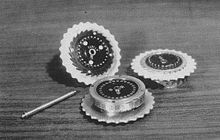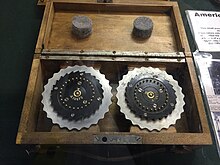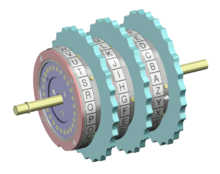Enigma rollers

During the Second World War , the German Wehrmacht used the Enigma rotor key machine to encrypt its secret communications . The heart of the machine is a set of rollers ( wheel set or scrambler for " scrambler "), which consists of an entry roller (ETW), depending on the model, three or four rollers (rotors) rotating during the encryption process and a reverse roller (VHF). Rollers and reversing rollers were usually selected from a somewhat larger range and inserted into the machine according to a (then) secret “ key board ”.
Decisive for the cryptographic security of the machine against unauthorized decipherment was the secrecy of the internal wiring of the rollers, which was tried, but not succeeded (see also: deciphering the Enigma ).
Roller wiring



The following table lists the internal wiring of the rollers of the different models of the key machine Enigma (abbreviations: ETW = entry roller, VHF = reversing roller). Some of the models were given certain aliases by the Allies , especially by the British code breakers in Bletchley Park , such as Rocket (German: "Rocket" after the steam locomotive " The Rocket " ) for the Reichsbahn-Enigma or Shark (German: "Hai") for the Enigma-M4 or the Triton key network , within which it was used.
| roller | A B C D E F G H I J K L M O P Q R S T U V W X Y Z | Introduction date | model |
|---|---|---|---|
| I (C) | [DMTWSILRUYQNKFEJCAZBPGXOHV] | 1924 | A and B |
| II (C) | [HQZGPJTMOBLNCIFDYAWVEUSRXL] | 1924 | A and B |
| III (C) | [UQNTLSZFMREHDPLKIBVYGJCWGA] | 1924 | A and B |
| roller | A B C D E F G H I J K L M O P Q R S T U V W X Y Z | Introduction date | model |
| ETW (D) | JWULCMNOHPQZYXIRADKEGVBTSF | 1926 | Commerce. D. |
| I (D) | LPGSZMHAEOQKVXRFYBUTNICJDW | 1926 | Commerce. D. |
| II (D) | SLVGBTFXJQOHEWIRZYAMKPCNDU | 1926 | Commerce. D. |
| III (D) | CJGDPSHKTURAWZXFMYNQOBVLIE | 1926 | Commerce. D. |
| FM (D) | IMETCGFRAYSQBZXWLHKDVUPOJN | 1926 | Commerce. D. |
| roller | 1 2 3 4 5 6 7 8 9 0 | Introduction date | model |
| ETW | 1 2 3 4 5 6 7 8 9 0 | 1930 | Enigma-Z |
| I. | 6 4 1 8 2 7 0 3 5 9 | 1930 | Enigma-Z |
| II | 5 8 4 1 0 9 7 6 3 2 | 1930 | Enigma-Z |
| III | 3 5 8 1 6 2 0 7 9 4 | 1930 | Enigma-Z |
| VHF | 5 0 7 9 1 8 3 6 4 2 | 1930 | Enigma-Z |
| roller | A B C D E F G H I J K L M O P Q R S T U V W X Y Z | Introduction date | model |
| ETW | QWERTZUIOASDFGHJKPYXCVBNML | February 7, 1941 | - |
| I. | JGDQOXUSCAMIFRVTPNEWKBLZYH | February 7, 1941 | Reichsbahn |
| II | NTZPSFBOKMWRCJDIVLAEYUXHGQ | February 7, 1941 | Reichsbahn |
| III | JVIUBHTCDYAKEQZPOSGXNRMWFL | February 7, 1941 | Reichsbahn |
| VHF | QYHOGNECVPUZTFDJAXWMKISRBL | February 7, 1941 | Reichsbahn |
| roller | A B C D E F G H I J K L M O P Q R S T U V W X Y Z | Introduction date | model |
| ETW | A B C D E F G H I J K L M O P Q R S T U V W X Y Z | 1930 | Enigma I |
| I. | EKMFLGDQVZNTOWYHXUSPAIBRCJ | 1930 | Enigma I |
| II | AJDKSIRUXBLHWTMCQGZNPYFVOE | 1930 | Enigma I |
| III | BDFHJLCPRTXVZNYEIWGAKMUSQO | 1930 | Enigma I |
| IV | ESOVPZJAYQUIRHXLNFTGKDCMWB | December 15, 1938 | M3 (army) |
| V | VZBRGITYUPSDNHLXAWMJQOFECK | December 15, 1938 | M3 (army) |
| VI | JPGVOUMFYQBENHZRDKASXLICTW | 1939 | M3 and M4 |
| VII | NZJHGRCXMYSWBOUFAIVLPEKQDT | 1939 | M3 and M4 |
| VIII | FKQHTLXOCBJSPDZRAMEWNIUYGV | 1939 | M3 and M4 |
| VHF A | EJMZALYXVBWFCRQUONTSPIKHGD | ||
| VHF B | YRUHQSLDPXNGOKMIEBFZCWVJAT | November 2, 1937 | |
| FM C | FVPJIAOYEDRZXWGCTKUQSBNMHL | 1940/41 | |
| roller | A B C D E F G H I J K L M O P Q R S T U V W X Y Z | Introduction date | model |
| ETW | A B C D E F G H I J K L M O P Q R S T U V W X Y Z | M4 | |
| beta | LEYJVCNIXWPBQMDRTAKZGFUHOS | February 1, 1942 | M4 |
| gamma | FSOKANUERHMBTIYCWLQPZXVGJD | July 1, 1943 | M4 |
| FM Bruno | ENKQAUYWJICOPBLMDXZVFTHRGS | February 1, 1942 | M4 |
| VHF Caesar | RDOBJNTKVEHMLFCWZAXGYIPSUQ | July 1, 1943 | M4 |
| roller | A B C D E F G H I J K L M O P Q R S T U V W X Y Z | Introduction date | model |
| ETW (K) | QWERTZUIOASDFGHJKPYXCVBNML | February 1939 | Swiss K |
| I (K) | PEZUOHXSCVFMTBGLRINQJWAYDK | February 1939 | Swiss K |
| II (K) | ZOUESYDKFWPCIQXHMVBLGNJRAT | February 1939 | Swiss K |
| III (K) | EHRVXGAOBQUSIMZFLYNWKTPDJC | February 1939 | Swiss K |
| FM (K) | IMETCGFRAYSQBZXWLHKDVUPOJN | February 1939 | Swiss K |
| roller | A B C D E F G H I J K L M O P Q R S T U V W X Y Z | Introduction date | model |
| ETW (T) | KZROUQHYAIGBLWVSTDXFPNMCJE | 1943 | Tirpitz |
| I (T) | KPTYUELOCVGRFQDANJMBSWHZXI | 1943 | Tirpitz |
| II (T) | UPHZLWEQMTDJXCAKSOIGVBYFNR | 1943 | Tirpitz |
| III (T) | QUDLYRFEKONVZAXWHMGPJBSICT | 1943 | Tirpitz |
| IV (T) | CIWTBKXNRESPFLYDAGVHQUOJZM | 1943 | Tirpitz |
| V (T) | UAXGISNJBVERDYLFZWTPCKOHMQ | 1943 | Tirpitz |
| VI (T) | XFUZGALVHCNYSEWQTDMRBKPIOJ | 1943 | Tirpitz |
| VII (T) | BJVFTXPLNAYOZIKWGDQERUCHSM | 1943 | Tirpitz |
| VIII (T) | YMTPNZHWKODAJXELUQVGCBISFR | 1943 | Tirpitz |
| FM (T) | GEKPBTAUMOCNILJDXZYFHWVQSR | 1943 | Tirpitz |
| roller | A B C D E F G H I J K L M O P Q R S T U V W X Y Z | Introduction date | model |
| ETW (G) | QWERTZUIOASDFGHJKPYXCVBNML | Enigma-G | |
| I (G31) | LPGSZMHAEOQKVXRFYBUTNICJDW | Enigma-G | |
| II (G31) | SLVGBTFXJQOHEWIRZYAMKPCNDU | Enigma-G | |
| III (G31) | CJGDPSHKTURAWZXFMYNQOBVLIE | Enigma-G | |
| VHF (G31) | IMETCGFRAYSQBZXWLHKDVUPOJN | Enigma-G | |
| I (G111) | WLRHBQUNDKJCZSEXOTMAGYFPVI | Enigma-G | |
| II (G111) | TFJQAZWMHLCUIXRDYGOEVBNSKP | Enigma-G | |
| V (G111) | QTPIXWVDFRMUSLJOHCANEZKYBG | Enigma-G | |
| VHF (G111) | IMETCGFRAYSQBZXWLHKDVUPOJN | Enigma-G | |
| I (G260) | RCSPBLKQAUMHWYTIFZVGOJNEXD | Enigma-G | |
| II (G260) | WCMIBVPJXAROSGNDLZKEYHUFQT | Enigma-G | |
| III (G260) | FVDHZELSQMAXOKYIWPGCBUJTNR | Enigma-G | |
| FM (G260) | IMETCGFRAYSQBZXWLHKDVUPOJN | Enigma-G | |
| I (G312) | DMTWSILRUYQNKFEJCAZBPGXOHV | Enigma-G | |
| II (G312) | HQZGPJTMOBLNCIFDYAWVEUSRKX | Enigma-G | |
| III (G312) | UQNTLSZFMREHDPXKIBVYGJCWOA | Enigma-G | |
| FM (G312) | RULQMZJSYGOCETKWDAHNBXPVIF | Enigma-G | |
| roller | A B C D E F G H I J K L M O P Q R S T U V W X Y Z | Introduction date | model |
| ETW | A B C D E F G H I J K L M O P Q R S T U V W X Y Z | 1945 | Norenigma |
| I. | WTOKASUYVRBXJHQCPZEFMDINLG | 1945 | Norenigma |
| II | GJLPUBSWEMCTQVHXAOFZDRKYNI | 1945 | Norenigma |
| III | JWFMHNBPUSDYTIXVZGRQLAOEKC | 1945 | Norenigma |
| IV | ESOVPZJAYQUIRHXLNFTGKDCMWB | 1945 | Norenigma |
| V | HEJXQOTZBVFDASCILWPGYNMURK | 1945 | Norenigma |
| VHF | MOWJYPUXNDSRAIBFVLKZGQCHET | 1945 | Norenigma |
Special circuits
With only a few exceptions, the specified reel wiring was never changed (thereby avoiding a significant cryptographic complication). The rare exceptions included machines for customers who expressly wanted exclusively wired rollers. Also for special fields of application of the machine, such as in the diplomatic service , especially for German military attachés in allied or neutral states, roller sets with their own roller wiring, called “special circuits”, were manufactured. Usually this only concerned the wiring of the rotors (I to III or I to V) and not the VHF, which kept its familiar wiring (see VHF B). However, there were also exceptions, such as the special machine with the type designation 17401S / jla / 43 found in the house of a former secret service employee in the 1980s . "17401" is the serial number of the machine, supplemented by "S" (presumably for "special"), "jla" the coded manufacturing code for the Heimsoeth & Rinke factory , and "43" the year of manufacture, i.e. 1943.
| roller | A B C D E F G H I J K L M O P Q R S T U V W X Y Z | Introduction date | model |
|---|---|---|---|
| I (S) | VEOSIRZUJDQCKGWYPNXAFLTHMB | 1943 | I. |
| II (S) | UEMOATQLSHPKCYFWJZBGVXINDR | 1943 | I. |
| III (S) | TZHXMBSIPNURJFDKEQVCWGLAOY | 1943 | I. |
| FM (S) | CIAGSNDRBYTPZFULVHEKOQXWJM | 1943 | I. |
These special roller sets were often identified with names from the German spelling alphabet of the time , i.e. Anton, Berta, Caesar, Dora, Emil or Friedrich, or with the help of Greek letters such as α ( alpha ), β ( beta ), γ ( gamma ) or δ ( delta ). The well-known Enigma machines with special circuitry include the thirty so-called "Delta machines" with the serial numbers A 16081 to A 16110. In July 1945 a group of the American Target Intelligence Committee (TICOM) managed to find such a Delta machine in Zagreb which had been used by the German military attaché there during the war to communicate with Berlin (attaché department in the OKH ).
Carry notches
Depending on the position of the transfer notch, which is located at different points on the various rollers, the roller adjacent to the left in the roller set rotates one position further (roller transfer) when a specific letter appears in the roller window of the roller to the right . For the rolls I to V, the code breakers at Bletchley Park had the (linguistically nonsensical) Merkspruch " R oyal F lags W ave K ings A bove" formed who calls the respective letters in that order, which always appears in the window after a Transfer to the next roller has taken place.
| roller | Carry notch | transfer |
|---|---|---|
| I. | Q | The transfer occurs when this roller rotates from Q to R. |
| II | E. | The transfer occurs when this roller rotates from E to F. |
| III | V | The transfer takes place when this roller rotates from V to W. |
| IV | J | The transfer occurs when this roller rotates from J to K. |
| V | Z | The transfer occurs when this roller rotates from Z to A. |
| VI, VII, VIII | Z + M | The carryover happens when changing from Z to A and from M to N. |
| Enigma-Z | The transfer takes place on all three reels at the transition from 9 to 0 | |
| Enigma-T ("Tirpitz") | The transfer takes place when changing from the specified letter to the alphabetically following letter | |
| I (T) | E, K, Q, W, Z | 5 transfer notches |
| II (T) | F, L, R, W, Z | 5 transfer notches |
| III (T) | E, K, Q, W, Z | 5 transfer notches |
| IV (T) | F, L, R, W, Z | 5 transfer notches |
| V (T) | C, F, K, R, Y | 5 transfer notches |
| VI (T) | E, I, M, Q, X | 5 transfer notches |
| VII (T) | C, F, K, R, Y | 5 transfer notches |
| VIII (T) | E, I, M, Q, X | 5 transfer notches |
| Defense Enigma (G) | The transfer takes place when changing from the specified letter to the alphabetically following letter | |
| I (G) | A, B, C, E, F, G, I, K, L, O, P, Q, S, U, V, W, Z | 17 transfer notches |
| II (G) | A, C, D, F, G, H, K, M, N, Q, S, T, V, Y, Z | 15 transfer notches |
| III (G) | A, E, F, H, K, M, N, R, U, W, X | 11 transfer notches |
Reversing roller D
The reversing roller D (also: reversing roller Dora, abbreviation: UKW D, called "Uncle Dick" by the British) is a special VHF, which is characterized by the fact that its wiring - in contrast to all other rollers of the Enigma - could be changed by the user depending on the key. It was used from January 1, 1944 by the German Air Force for the Enigma I in some key areas in France and Norway.
Gap filler rollers
A significant innovation that would have significantly improved the cryptographic security of the Enigma, but which came too late to be used during the war, were the so-called "gap filler rollers" ( see photo under web links ). These new types of rotors made it possible to “set any type and number of switching gaps on each roller”. The settings could have been changed depending on the key and thus contributed significantly to the cryptographic strengthening of the machine. The American Target Intelligence Committee (TICOM) confiscated all information about the gap filler roller towards the end of the war and carefully kept it under lock and key for many years. If it could have been manufactured and used in sufficient numbers, the British code breakers would probably have been out of the running, especially if the gap filler roller had been used in combination with the reversing roller D as planned .
literature
- Friedrich L. Bauer : Deciphered Secrets. Methods and maxims of cryptology. 3rd, revised and expanded edition. Springer, Berlin et al. 2000, ISBN 3-540-67931-6 .
- David H. Hamer : G-312. To defense Enigma . Cryptologia. Rose-Hulman Institute of Technology. Taylor & Francis, Philadelphia PA 24.2000.1 (January). ISSN 0161-1194 PDF; 1.1 MB ( Memento from June 11, 2007 in the Internet Archive )
- David H. Hamer et al .: Enigma Variations: An Extended Family of Machines . Cryptologia. Rose-Hulman Institute of Technology. Taylor & Francis, Philadelphia PA 22.1998.1 (July). ISSN 0161-1194 PDF; 0.1 MB ( memento from September 1, 2007 in the Internet Archive )
- Francis Harry Hinsley , Alan Stripp: Codebreakers - The inside story of Bletchley Park . Oxford University Press, Reading, Berkshire 1993. ISBN 0-19-280132-5
- Philip Marks , Frode Weierud : Recovering the wiring of Enigma's reverse roller A . PDF; 0.2 MB ( Memento from June 11, 2007 in the Internet Archive )
- Anders Wik: Enigma Z30 retrieved. Cryptologia, 2015, doi : 10.1080 / 01611194.2015.1055387 .
Web links
- Crypto Museum (English). Retrieved March 7, 2016
- Enigma Rotors - Class Identification and Wiring (English). Retrieved March 7, 2016
- Virtual Bletchley Park (English). Retrieved March 7, 2016
- Photo of the gap filler roller . Retrieved March 7, 2016
- Gap filler roller in the Crypto Museum (English). Retrieved March 7, 2016
- Interrogation of Dr. Otto Buggisch of OKW / Chi. TICOM document, 1945 PDF; 3.6 MB (English) p. 4, accessed on September 13, 2018.
- Fuensanta, Espiau and Weierud: Spanish Enigma: A History of the Enigma in Spain . PDF; 650 kB (English) accessed on October 17, 2018.
Individual evidence
- ↑ Anders Wik: Enigma Z30 retrieved. Cryptologia, 2015, p. 4. doi : 10.1080 / 01611194.2015.1055387 .
- ↑ José Ramón Soler Fuensanta, Francisco Javier López-Brea Espiau and Frode Weierud: Spanish Enigma: A History of the Enigma in Spain . Cryptologia. Rose-Hulman Institute of Technology. Taylor & Francis, Philadelphia PA 34.2010,4 (October), p. 310. ISSN 0161-1194 .
- ↑ Special Enigma in the Crypto Museum , accessed on January 31, 2019.
- ↑ José Ramón Soler Fuensanta, Francisco Javier López-Brea Espiau and Frode Weierud: Spanish Enigma: A History of the Enigma in Spain . Cryptologia. Rose-Hulman Institute of Technology. Taylor & Francis, Philadelphia PA 34.2010,4 (October), p. 313. ISSN 0161-1194 .
- ↑ Anders Wik: Enigma Z30 retrieved. Cryptologia, 2015, p. 3. doi : 10.1080 / 01611194.2015.1055387 .
- ↑ Michael Pröse: Encryption machines and deciphering devices in the Second World War - the history of technology and aspects of the history of IT . Dissertation at Chemnitz University of Technology, Leipzig 2004, p. 43f.
- ^ Army Security Agency: Notes on German High Level Cryptography and Cryptanalysis . European Axis Signal Intelligence in World War II, Vol 2, Washington (DC), 1946 (May), p. 2. Accessed: August 24, 2018. PDF; 7.5 MB ( memento from June 11, 2014 in the Internet Archive )





